
images/Marasmius_oreades/Marasmius_oreades.jpg
Small to medium agaric, growing on the ground among grass, with a white or cream to yellow spore print. Pileus pale or pinkish brown (to brownish orange at centre), hygrophanous, not viscid. Lamellae free, adnexed or sinuate or notched. Stipe central. Partial veil remnants absent. Spores hyaline, non-amyloid, smooth; germ pore absent. Cheilocystidia absent. Lamellar trama regular. Pileipellis a hymeniderm, with smooth, clavate terminal elements. Clamp connections present.
Most of the small to medium agarics that grow on the ground in lawns have a brown to black spore print (as in
Panaeolina and
Psathyrella). The rather tough, rubbery texture and strong odour also serve to identify
Marasmius oreades, which differs from other white-spored agarics in lawns by the absence of an annulus, smooth spores and the hymeniderm pileipellis.
Gymnopus, which can have relatively tough fruit-bodies, has a pileipellis that is a cutis or trichoderm, often of branched or nodulose hyphae, and the stipe is often hairy.
One species:
Marasmius oreades.
This species is keyed out separately because it is larger than most other Marasmius and also differs by the habitat in grass and lawns and the absence of a dark base to the stipe. Marasmius riawunnus, from South Australia growing in fairy rings in grass (Grgurinovic, 1997) seems quite close, and can be a synonym.
Marasmius oreades (Bolton : Fr.) Fr.,
Epicr. Syst. Mycol. 375 (1838).
S.A., N.S.W., Vic. and Tas.
In lawns in parks and gardens. Also occasionally found among patches of exotic grass in native forests. Forms fairy rings.
On the ground.
Saprotrophic.
Breitenbach, J. & Kränzlin, F. (eds) (1991),
Fungi of Switzerland.
Volume 3. Boletes and Agarics 1st part. Edition Mykologia, Lucerne. [
Illustration,
Description and
Microcharacters of
M. oreades from Europe]
Fuhrer, B. (2005), A Field Guide to Australian Fungi. Bloomings Books, Hawthorn. [Description and Illustration of M. oreades]
Grey, P. & Grey, E. (2005), Fungi Down Under. Fungimap, South Yarra. [Description, Illustration and Map for M. oreades]
Grgurinovic, C.A. (1997a), Larger Fungi of South Australia. The Botanic Gardens of Adelaide and State Herbarium and The Flora and Fauna of South Australia Handbooks Committee, Adelaide. [Description and Microcharacters of M. oreades]
McCann, I.R. (2003), Australian Fungi Illustrated. Macdown Productions, Vermont. [Illustration of M. oreades]


